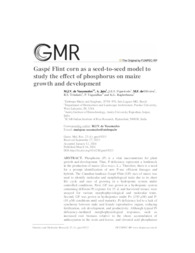Gaspé Flint corn as a seed-to-seed model to study the effect of phosphorus on maize growth and development.
Gaspé Flint corn as a seed-to-seed model to study the effect of phosphorus on maize growth and development.
Autoria: VASCONCELOS, M. J. V. de; JAIN, A.; FIGUEIREDO, J. E. F.; OLIVEIRA, M. F. de; TRINDADE, R. dos S.; YUGANDHAR, P.; RAGHOTHAMA, K. G.
Resumo: Phosphorus (P) is a vital macronutrient for plant growth and development. Thus, P deficiency represents a bottleneck in the production of maize (Zea mays, L.). Therefore, there is a need for a prompt identification of new P-use efficient lineages and hybrids. The Canadian landrace Gaspé Flint (GF) race of maize was used to identify molecular and morphological traits due to its short life cycle and ease of growing in a hydroponic system under controlled conditions. First, GF was grown in a hydroponic system containing different Pi regimes for 15 d, and harvested tissues were assayed for various morphophysiological and molecular traits. Second, GF was grown in hydroponics under P+ (250 µM) and P-(10 µM) conditions until seed maturity. Pi deficiency led to a lack of synchrony between male and female reproductive organs, reducing fertilization, cob development, and productivity. Although typical Pi deficiency-mediated morphophysiological responses, such as increased root biomass relative to the shoot, accumulation of anthocyanins in the roots and leaves, and elevated acid phosphatase activity in the shoot could be observed in any maize variety, the use of GF abbreviated the analysis of these traits from 120 days in commercial varieties to 40 days. Furthermore, Pi transporters ZmPT5 and ZmPT6 were induced in Pi-deprived roots and leaves and suppressed upon Pi replenishment, suggesting a transcriptional regulation. The study validated the efficacy of GF for accelerating studies on agronomic traits and plant response to stress, from seeds to seeds, in the grass family. The Gaspé Flint corn was confirmed as a plant model to study the effect of phosphorus on the growth and development of maize in a hydroponic system.
Ano de publicação: 2024
Tipo de publicação: Artigo de periódico
Unidade: Embrapa Milho e Sorgo
Palavras-chave: Agronomic traits, Características Agronômicas, Endogamia, Inbred lines, Linhagem, Milho, Zea Mays
Observações
1 - Por padrão são exibidas publicações dos últimos 20 anos. Para encontrar publicações mais antigas, configure o filtro ano de publicação, colocando o ano a partir do qual você deseja encontrar publicações. O filtro está na coluna da esquerda na busca acima.
2 - Para ler algumas publicações da Embrapa (apenas as que estão em formato ePub), é necessário ter, no celular ou computador, um desses softwares gratuitos. Sistemas Android: Google Play Livros; IOS: iBooks; Windows e Linux: software Calibre.
Acesse outras publicações
Acesse a Base de Dados da Pesquisa Agropecuária (BDPA) para consultar o acervo completo das bibliotecas da Embrapa.

